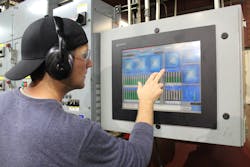Scale Microgrid Solutions is on a mission to make sophisticated microgrids as easy to deploy and finance as rooftop solar, said Timothy Hade, microgrid specialist for the company.
“Our thesis is that at scale, microgrids have all sorts of great technical aspects that can make our total energy system cleaner, cheaper and more reliable. But the challenge is how to make microgrid deployment as easy as rooftop solar deployment,” he said.
One of numerous challenges to getting more microgrid deployed: High skill levels are generally required. “Most of the projects that get done well are done by one of 50 or 60 different developers that can make these projects work,” he said.
But what if electrical contractors could deploy microgrids, in much the same way they can deploy rooftop solar right now?
“The thing that made rooftop solar take off: The industry made the process simple enough so that an electrical contractor who put time into learning could start offering rooftop installations,” he said.
Scale Microgrid’s farm example
Hade said his company aims to help the microgrid industry take off by offering both a simple, replicable system plus financing packages. Scale Microgrid, which was launched in 2015, now has three microgrid projects up and running. Two are projects the company took over from other developers. The Bowery Farming microgrid in New Jersey is its first new build.
That microgrid exemplifies the simplicity the company seeks, Hade said. Bowery Farming will reduce its carbon footprint by about 50 percent using energy from a microgrid that will rely on solar, energy storage and natural gas. Schneider Electric will provide the lithium-ion battery energy storage system, the microgrid controller and a cloud-connected energy management software platform. The indoor farm will be able to island from the grid during a power outage and depend on its on-site generators. At some point, it’s expected to earn revenue by providing ancillary services.
“The Bowery Microgrid is a natural gas generator, lithium ion battery and rooftop solar. Those three components are readily available on the market today,” Hade said. “It’s the simplest microgrid we’ve ever built.”
An average developer can learn about this for two weeks and be ready to go.
This microgrid could be deployed at several hundred facilities across New Jersey, he said. Any certified electrical contractor could learn to develop this type of microgrid. “If you deploy several hundred of these systems, you would never have to build a peaker plant again in New Jersey,” he said.
“The Bowery system is about making that facility as flexible as possible to interact with the grid,” he added.
If the grid needs capacity, the full capacity of the microgrid can be taken off the grid. When there’s plenty of wind and solar on the system, Bowery could take no grid energy and depend 100 percent on the microgrid, he explained.
“Nothing is stopping commercial and industrial facilities from installing a similar system. An average developer can learn about this for two weeks and be ready to go.” That’s a big departure from spending four or five years to develop a microgrid, he said.
The role of natural gas
One of the features that makes a Bowery-type microgrid easy to deploy is natural gas.
“A ‘lightbulb’ for us was that natural gas, if properly utilized, is a natural complement to solar and storage,” he said. “It allows us to do things from a contractual and financial standpoint that makes these systems economically viable.”
Adding natural gas unlocks value that commercial and industrial facility owners appreciate, he said. Usually the executive team of a commercial or industrial facility doesn’t see solar plus storage as economically viable. But adding natural gas can gain the team’s buy-in.
“Ultimately, it’s about time-of-use rates and flexibility,” he said. “If you want a value proposition of being cleaner and cheaper, it comes down to how to use gas in creative ways to make that happen.”
Join Microgrid Knowledge in San Diego at Microgrid 2019: Shaping the New Electric Grid, May 14-16
For example, the company is working on a project in Colorado with abundant sunshine during the day and some wind at night, but the main energy source is still coal, Hade said.
“In that situation, if our client needs electrons, it’s more sustainable to make them with a natural gas generator than a coal-fired plant. If you know the environmental profile of your system, you can look at the grid mix.” When the grid mix is less sustainable, the microgrid, even with natural gas, will be more sustainable than coal, he explained.
The company is also focusing on deregulated states in the East. In PJM territory, for example, a published emergency capacity rate is available. During peak events, microgrids can be taken off-line or operators can turn their generators on and get paid market rates for providing peak power.
“That type of program doesn’t exist in any regulated utility. We’re trying to figure out how to get utilities to value the ancillary services these systems provide to the grid,” said Hade.
Bankable template contracts
Meanwhile, Scale Microgrid wants to address financing challenges with one of three standard options.
“Equal to the technical side, we’ve spent a whole lot of time on the contractual side, figuring out how you build template contracts that can be bankable,” he said.
The first model is an energy services contract, in which Scale Microgrid owns and operates the microgrid, and the customer pays on a kWh-hour basis. That’s the model used for the Bowery Microgrid project.
“Given the current rate structure, the project is saving Bowery a significant amount of money every year. We take the risk and Bowery does not; that’s a model that should be the prevalent model,” said Hade.
The company also offers leasing and an option in which the customer provides the capital. “They give us, say, $3.5 million, we build the project, and there’s generally a long-term operations and maintenance contract” with Scale, he said.
Living up to its name
A stumbling block for Scale Microgrid — and the microgrid industry at large — is the lack of consistent interconnection standards from utility to utility. Every time the company goes into a new territory, it has to learn new standards, Hade said. And there’s no quick solution to that challenge.
So for now, the company is focusing on technologies that make sense within today’s framework — always with an eye toward doing just what its name implies — scale microgrids.
Track news about companies like Scale Microgrid Solutions. Follow Microgrid Knowledge on LinkedIn.








